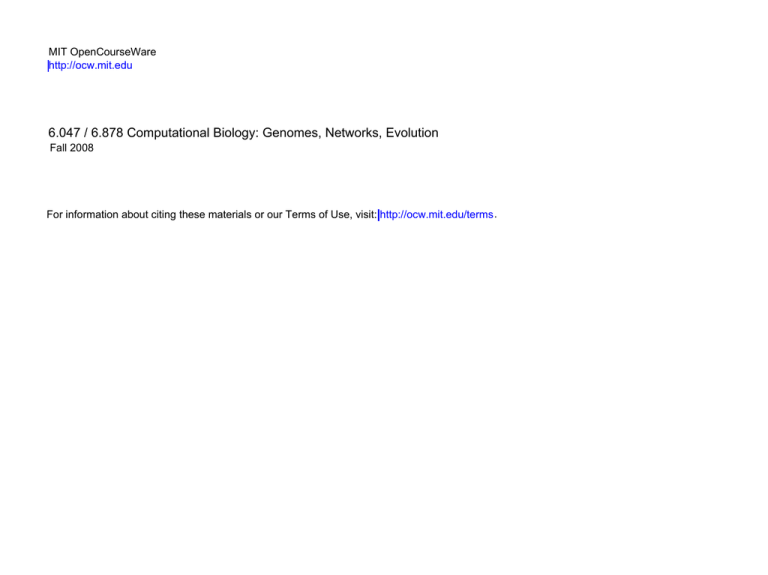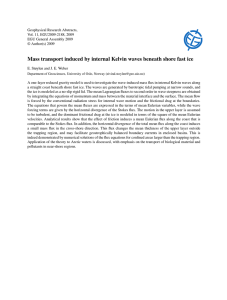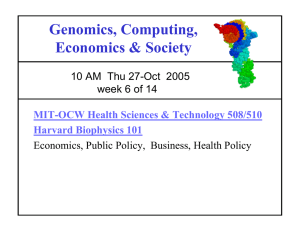Document 13591669
advertisement

MIT OpenCourseWare http://ocw.mit.edu 6.047 / 6.878 Computational Biology: Genomes, Networks, Evolution Fall 2008 For information about citing these materials or our Terms of Use, visit: http://ocw.mit.edu/terms. 6.047/6.878 Computational Biology: Genomes, Networks, Evolution Introduction to Steady State Metabolic Modeling Systems Biology and Metabolic Modeling • Steady State Metabolic Modeling • Expression, Regulation, and Steady State Metabolic Modeling • Advanced Systems Modeling What is Metabolism? “The totality of all chemical reactions that occur in living matter” Matthews & van Holde, Biochemistry Most commonly, these refer to reactions involved in 1) The generation and storage of energy and oxidationreduction products - ATP, NADH, NADPH 2) The creation or destruction of cell structural components - Proteins, Lipids, Carbohydrates, Nucleic Acids But we should also properly include: 3) The transduction and transmission of information - More commonly studies as signaling and genetics today Why Model Metabolism? • Predict the effects of drugs on metabolism – e.g. what genes should be disrupted to prevent mycolic acid synthesis • Interpret gene expression data in the context of metabolism – e.g. what metabolic state corresponds to a particular expression profile • Many infectious disease processes involve microbial metabolic changes – e.g. switch from sugar to fatty acid metabolism in TB in macrophages Enzymes Transition state (activated complex between glucose and ATP) EA of uncatalyzed reaction in forward direction Free energy Reactants EA of enzyme-catalyzed reaction in forward direction Glucose + ATP Initial state ∆Go of reaction = --- 4 kcal/mol Products Glucose 6-phosphate + ADP Final state Course of reaction Figure by MIT OpenCourseWare. Reaction Rates A +2B → 3C Formation rates v fA d[A] = dt v fB d[B] = dt v fC d[C ] = dt Reaction Rate = Reaction Velocity = Reaction Flux d[A] 1 d[B] 1 d[C] v= = = dt 2 dt 3 dt Steady State Assumptions • Dynamics are transient • At appropriate timescales and conditions, metabolism is in steady state Two key implications 1. Fluxes are roughly constant 2. Internal metabolite concentrations are constant v1 vin B A v4 v3 d [ A] dt v2 D C vout v5 = vin − v1 − v3 = 0 Metabolic Flux Input fluxes Volume of pool of water = metabolite concentration Output fluxes Figure by MIT OpenCourseWare. Reaction Stoichiometries Are Universal The conversion of glucose to glucose 6-phosphate always follows this stoichiometry : 1ATP + 1glucose = 1ADP + 1glucose 6-phosphate This is chemistry not biology. Biology => the enzymes catalyzing the reaction Enzymes influence rates and kinetics • Activation energy Not required for steady • Substrate affinity state modeling! • Rate constants Metabolic Flux Analysis Use universal reaction stoichiometries to predict metabolic network capabilities at steady state* (Famili et al (2003) PNAS) Famili, Iman, et al. "Saccharomyces Cerevisiae Phenotypes can be Predicted by Using Constraint-based Analysis of a Genome-scale Reconstructed Metabolic Network.." PNAS 100, no. 23 (2003): 13134-13139. Copyright (2003) National Academy of Sciences, U.S.A. *Not precise, but more precision will come in later slides Stoichiometry As Vectors • We can denote the stoichiometry of a reaction by a vector of coefficients • One coefficient per metabolite – Positive if metabolite is produced – Negative if metabolite is consumed Example: Metabolites: Reactions: Stoichiometry Vectors: [ A B C D ]T 2A + B -> C [ -2 -1 1 0 ]T C -> D [ 0 0 -1 1 ]T The Stoichiometric Matrix dA/dt dB/dt dC/dt dD/dt dE/dt dF/dt dG/dt dH/dt dI/dt R1 R2 R3 R4 R5 R6 R7 R8 R9 R10 A B C D =E F G H I -1 0 0 -2 0 0 1 0 1 0 -1 0 -1 0 0 0 1 0 Let V be a vector of fluxes through each reaction Then S*V is a vector describing the change in concentration of each metabolite per unit time v1 v2 v3 v4 v5 v6 v7 v8 v9 v10 dx = S •V dt A (Very) Simple System v1 vin B A v2 v4 v3 D C vout v5 A B C D v1 v2 v3 v4 v5 vin vout -1 0 -1 0 0 1 0 1 -1 0 0 0 0 0 0 1 0 -1 1 0 -1 0 0 1 1 -1 0 0 Exchange Reactions We have introduced two new things • Reversible reactions – are represented by two reactions that proceed in each direction (e.g. v4, v5) • Exchange reactions – allow for fluxes from/into an infinite pool outside the system (e.g. vin and vout). These are frequently the only fluxes experimentally measured. Some advantages of S • Chemistry not Biology: the stoichiometry of a given reaction is preserved across organisms, while the reaction rates may not be preserved • Does NOT depend on kinetics or reaction rates • Depends on limited thermodynamic data – only reversibility/irreversibility Genes to Reactions • Expasy enzyme database • Indexed by EC number • EC numbers can be assigned to genes by – Blast to known genes – PFAM domains Online Metabolic Databases There are several online databases with curated and/or automated EC number assignments for sequenced genomes Pathlogic/BioCyc Images removed due to copyright restrictions. Please see: http://biocyc.org/intro.shtml http://www.genome.jp/kegg/ Kegg From Genomes to the S Matrix Examples Columns encode reactions Gene A Relationships btw genes and rxns -1 gene 1 rxn -1 gene 1+ rxns -1+ genes 1 rxn Enzyme A The same reaction can be included as multiple roles (paralogs) Gene B Gene C Enzyme B/C Gene D Enyzme D Gene E Gene E’ Enzyme E Enzyme E’ R1 R2 R3 R4 R5 R6 R7 R8 R9 R10 A B C D E F G H I -1 0 0 -2 0 0 1 0 1 0 -1 0 -1 0 0 0 1 0 Same rxn What Can We Use S For? From S we can determine what combination of fluxes are possible in the system and what are not To get there we need three concepts: 1. Nullspace of S 2. Extreme Pathways 3. Constrained Flux Space The Steady State Assumption and S dx • We have = S •V dt • But also recall that at steady state, metabolite concentrations are constant: dx/dt=0 dx = S •V = 0 dt Steady State fluxes are constrained to the nullspace of S The Nullspace of S reaction 3 flux • Subspace of flux vectors that do not change metabolite concentrations • Can describe nullspace with non-unique basis vectors, bi • All nullspace fluxes are linear combinations of this basis: V = ∑ α i bi i • Can find a basis using standard methods (e.g. SVD) reaction 2 flux reaction 1 flux dx = S •V dt dx3 dt dx2 dt dx1 dt Example Nullspace Basis v1 vin v2 A C v3 b1 v1 vin B A D B v4 v2 C b2 v3 D vout A B C D v1 v2 v3 v4 vin vout -1 0 -1 0 1 0 1 -1 0 0 0 0 0 1 0 1 0 -1 0 0 1 -1 0 0 vout v4 b2 includes negative fluxes that are not thermodynamically possible b1 1 1 0 0 1 1 -> Need to constrain the nullspace b2 1 1 -1 -1 0 0 v1 v2 v3 v4 vin vout Extreme Pathways • The most fundamental constraint is that all fluxes must be positive* • In this case, we have the following linear homogeneous equation system: 0 = S ⋅V , vi ≥ 0, i = 1..n • Solution to this set of equations is an exercise in convex analysis • Solution region can be described by a unique set of Extreme Pathways *recall that reversible reactions are represented by two unidirectional fluxes The Flux Cone Extreme pathways circumscribe a convex flux cone flux v3 p3 p2 • Every steady state flux vector, v, is a non-negative combination of these pathways: V = ∑ α i pi p4 v αi ≥ 0 i • Extreme pathways represent underlying pathway structure of system p1 flux v1 flux v2 Nullspace Flux Cone Vector space defined by set of non-unique basis vectors Vector space defined by set of non-unique basis vectors Every flux in space uniquely Every flux in space nonrepresented as linear uniquely represented as combination of basis vectors non-negative combination of extreme pathways # Basis vectors = dimension # Extreme pathways > of nullspace dimension of nullspace Constraining the Solution Space • No reaction has capacity for infinite flux • Often one can estimate constraints on transfer fluxes – Max glucose uptake measured at maximum growth rate – Max oxygen uptake based on diffusivity equation • Flux constraints result in constraints on extreme pathways – Need enough constraints to ‘cover’ extreme pathways max flux v3 flux v3 p2 flux v3 p3 p2 p3 p4 p4 p1 p1 flux v1 flux v2 flux v1 flux v2 The Constrained Flux Cone • Contains all achievable flux distributions given the constraints: flux v3 p2 – Stoichiometry – Reversibility – Max and Min Fluxes p3 p4 • Only requires: – Annotation – Stoichiometry – Small number of flux constraints (small relative to number of reactions) p1 flux v1 flux v2 Selecting One Flux Distribution • At any one point in time, organisms have a single flux distribution flux v3 p2 p3 p4 • How do we narrow down the range of predicted flux distributions (ideally to one)? p1 flux v1 flux v2 What if we assume organisms are trying to maximize a “fitness” function that is a function of fluxes? Linear Programming If we assume the objective function is a linear function of fluxes, we can use linear programming to find a solution Linear Programming Example x1 rA ATP A B rB x2 Maximize: NADH z = ∑ ci vi = c v T Figure by MIT OpenCourseWare. i Subject to: Maximize NADH flux x2 xi ≥ 0 NADH=c2 Ax < b x≥0 ra ≤ const. NADH=c1 x1+x2=ra Maximize ATP Solution always lies at boundary of admissible space Can be found using simplex algorithm Constraints: NADH=c3 flux x1 admissible space From Bonarius et al TIBTECH vol 15:308 (1997) Optimizing E. coli Growth For one gram of E. coli biomass, you need this ratio of metabolites Assuming a matched balanced set of metabolite fluxes, you can formulate this objective function Metabolite (mmol) ATP 41.257 NADH -3.547 NADPH 18.225 G6P 0.205 F6P 0.0709 R5P 0.8977 E4P 0.361 T3P 0.129 3PG 1.496 PEP 0.5191 PYR 2.8328 AcCoA 3.7478 OAA 1.7867 AKG 1.0789 Z = 41.257vATP - 3.547vNADH + 18.225vNADPH + 0.205vG6P + 0.0709vF6P +0.8977vR5P + 0.361vE4P + 0.129vT3P + 1.496v3PG + 0.5191vPEP +2.8328vPYR + 3.7478vAcCoA + 1.7867vOAA + 1.0789vAKG FBA Summary Stoichiometric Matrix Feasible Space Optimal Flux Gene annotation Enzyme and reaction catalog S*v=0 Growth objective Z=c*v Add constraints: vi>0 αi>vi>βi Glucose 2.37nm Glycogen a b Solve with linear programming G6P G1P F6P F2,6BP flux v3 0.33nm Minor groove p2 G3P 3.40nm ADP Major groove AMP ATP cAMP ATP BPG p3 3PG ADP p3 p4 p4 PEP Base pair Lactate Pyruvate Fatty acids Acetyl-CoA ATP p2 DHAP 2PG Sugar-phosphate backbones Flux solution flux v3 FBP p1 p1 flux v1 flux v2 Citric acid cycle Citrate Next some applications of FBA…. flux v1 flux v2 Applications in silico Deletion Analysis Can we predict gene knockout phenotype based on their simulated effects on metabolism? Q: Why, given other computational methods exist? (e.g. protein/protein interaction map connectivity) A: Other methods do not directly consider metabolic flux or specific metabolic conditions in silico Deletion Analysis “wild-type” v1 vin B A v2 v4 v3 D C vout v5 A B C D v1 v2 v3 v4 v5 vin vout -1 0 -1 0 0 1 0 1 -1 0 0 0 0 0 0 1 0 -1 1 0 -1 0 0 1 1 -1 0 0 A B C D v1 v2 v3 v4 v5 vin vout -1 0 -1 0 0 1 0 1 -1 0 0 0 0 0 0 1 0 -1 1 0 -1 0 0 1 1 -1 0 0 “mutant” v1 vin B A v2 v4 v3 D v5 C vout Gene knockouts modeled by removing a reaction Mutations Restrict Feasible Space • • • • KO removes fluxes, and extreme pathways that depend on these fluxes FluxC Feasible space is constrained If original optimal flux is outside new space, new optimal flux is created Growth rate at new solution provides a measure of KO phenotype FluxC FluxB FluxA Calculate new optimal flux FluxB FluxA FluxC No change in optimal flux FluxB FluxA Figure by MIT OpenCourseWare. Mutant Phenotypes in E. coli Edwards, J.S., and B.O. Palsson. "The Escherichia coli MG1655 in silico metabolic genotype: Its definition, characteristics, and capabilities." PNAS 97, no. 10 (2000): 5528-5533. Model of E. coli central metabolism 436 metabolites 720 reactions Simulate mutants in glycolysis, pentose phosphate, TCA, electron transport E. coli KO simulation results in vivo in silico + + - 36 2 If Zmutant/Z =0, mutant is no growth (-), growth (+) otherwise Compare to experiment 9 32 (in vivo / in silico) 86% agree Measured optimal growth of Condition specific mutants (Zmutant) versus nonprediction mutant (Z) Simulated growth on glucose “reduced growth” “lethal” Edwards, J. S., and B. O. Palsson. "The Escherichia coli MG1655 in Silico Metabolic Genotype: Its Definition, Characteristics, and Capabilities." PNAS 97, no. 10 (2000): 5528-5533. Copyright (2000) National Academy of Sciences, U.S.A. Edward & Palsson (2000) PNAS What do the errors tell us? • Errors indicate gaps in model or knowledge • Authors discuss 7 errors in prediction – fba mutants inhibit stable RNA synthesis (not modeled by FBA) – tpi mutants produce toxic intermediate (not modeled by FBA) – 5 cases due to possible regulatory mechanisms (aceEF, eno, pfk, ppc) Edward & Palsson (2000) PNAS Yeast Metabolic Model • • • • • • 1175 Reactions 585 Metabolites Accounts for 708 (16%) genes Includes 140 reactions w/o known genes Cytosol and mitochondria compartments Palsson group continues to update and improve model Image removed due to copyright restrictions. Figure 1, Reconstruction of the metabolic network of S. cerevisiae. Forster, Jochen, et al. "Genome-Scale Reconstruction of the Saccharomyces Cerevisiae Metabolic Network." Genome Research 13 (2003): 244-253. Model available at http://systemsbiology.ucsd.edu Forster et al. (2003) Genome Res Yeast Knockout Analysis Reported: 81.5% agreement 93 of 114 cases But broken down by case: in vivo in silico + - + 86 20 - 0 3 Many errors of (+/-) - 7 predict retarded growth - Others can be explained by unmodeled regulation Eukaryotic model needs gene regulation Famili et al. (2003) PNAS Famili, Iman, et al. "Saccharomyces Cerevisiae Phenotypes can be Predicted by Using Constraint-based Analysis of a Genome-scale Reconstructed Metabolic Network." PNAS 100, no. 23 (2003): 13134-13139. Copyright (2003) National Academy of Sciences, U.S.A. Resources • Tools and Databases – Kegg – BioCyc – PathwayExplorer (pathwayexplorer.genome.tugraz.at) • Metabolic Modeling – – – – Palsson’s group at UCSD (http://gcrg.ucsd.edu/) www.systems-biology.org Biomodels database (www.ebi.ac.uk/biomodels/) JWS Model Database (jjj.biochem.sun.ac.za/database/index.html)


![Jeffrey C. Hall [], G. Wesley Lockwood, Brian A. Skiff,... Brigh, Lowell Observatory, Flagstaff, Arizona](http://s2.studylib.net/store/data/013086444_1-78035be76105f3f49ae17530f0f084d5-300x300.png)


